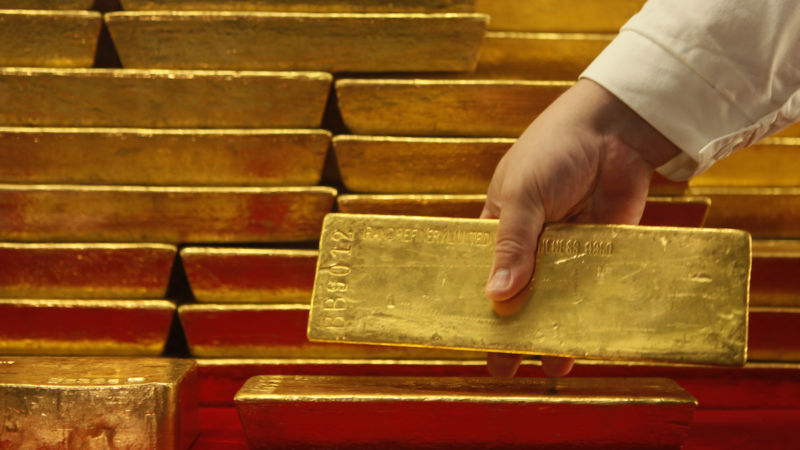Gold bars fraudulently stamped with the logos of major refineries are being inserted into the global market to launder smuggled or illegal gold, refining and banking executives have told Reuters. The fakes are hard to detect, making them an ideal fund-runner for narcotics dealers or warlords.
In the last three years, bars worth at least $50 million stamped with Swiss refinery logos, but not actually produced by those facilities, have been identified by all four of Switzerland’s leading gold refiners and found in the vaults of JPMorgan Chase & Co., one of the major banks at the heart of the market in bullion, senior executives at gold refineries, banks and other industry sources said.
Four of the executives said at least 1,000 of the bars, of a standard size known as a kilobar for their weight, have been found. That is a small share of output from the gold industry, which produces roughly 2 million to 2.5 million such bars each year, many of them in Switzerland. But the forgeries are sophisticated, so thousands more may have gone undetected, according to the head of Switzerland’s biggest refinery.
“The latest fake bars… are highly professionally done,” said Michael Mesaric, the chief executive of refinery Valcambi. He said maybe a couple of thousand have been found, but the likelihood is that there are “way, way, way more still in circulation. And it still exists, and it still works.”
“It’s a wonderful way of laundering conflict gold,” said Richard Hayes, chief executive of the Perth Mint in Australia, one of the world’s largest refiners. “The gold is genuine, but it’s not ethically sourced… .”
Fake gold bars — blocks of cheaper metal plated with gold — are relatively common in the gold industry and often easy to detect. The counterfeits in these cases are subtler: The gold is real, and very high purity, with only the markings faked.
Fake-branded bars are a relatively new way to flout global measures to block conflict minerals and prevent money-laundering. By pirating Swiss and other major brands, metal that has been mined or processed in places that would not otherwise be legal or acceptable in the West — for example in parts of Africa, Venezuela or North Korea — can be injected into the market, channeling funds to criminals or regimes that are sanctioned.
Kilobars are small — around the size and thickness of a cell phone — and are the most common form of gold in circulation around the world, passing fluidly between banks, refineries, dealers and individuals. Each one is worth around $50,000 at current prices.
People in the industry told Reuters the number of forged bars, and their high quality, meant their production must be well organized. They said it was not clear who is making the bars found so far, but an analysis of their movements suggested they had been made in Asia, probably China, and entered the market via dealers and trading houses in Hong Kong, Japan and Thailand. The gold in them, however, could have been melted and re-melted after being mined anywhere. Once accepted by a mainstream gold dealer, they can quickly spread into supply chains worldwide.
“It’s a wonderful way of laundering conflict gold,” said Richard Hayes, chief executive of the Perth Mint in Australia, one of the world’s largest refiners. “The gold is genuine, but it’s not ethically sourced… They (the bars) look completely genuine, they assay correctly, and they weigh correctly as well.”
“Because gold is completely fungible,” he said, “you can bleed it into genuine production. It’s very, very hard to control.” Hayes said his company had not encountered fraudulently branded Perth Mint kilobars, but, given the experience of other refiners, he has no doubt they are circulating.
The number of fake bars being found has dropped since 2017. But refiners say the forgeries are becoming increasingly sophisticated, so the problem may have grown.
J.P. Morgan declined to directly address questions about the fraudulent bullion. It said its standard practice was to alert authorities and refineries if it discovered mismarked gold kilobars and had not had an incident resulting in a loss to the bank or its clients.
The number of fake bars being found has dropped since 2017. But refiners say the forgeries are becoming increasingly sophisticated, so the problem may have grown. The most reliable way to identify the fakes is to test their purity, refiners said. For professionally produced kilobars, the most common standard is 99.99% pure — known in the trade as “four nines.” An analysis of three counterfeit-branded bars by one Swiss refinery showed that two of them were 99.98% pure, and the third 99.90%.
Refineries are responding to the problem with technology allowing buyers to verify their bars are genuine. The London Bullion Market Association, which sets standards in the industry, plans a global database containing information about every kilobar produced, as a way of cross-checking the products. Many banks have tightened their purchasing policies, in part due to the appearance of counterfeits, people familiar with the matter say.
But many of these measures are only now being rolled out. They may stamp out the problem, but it will take time.
This article was written by Peter Hobson, a journalist for Reuters







